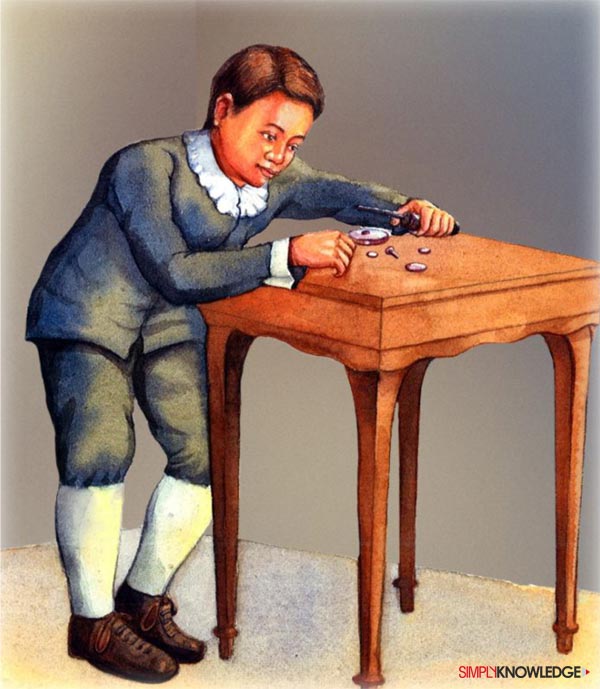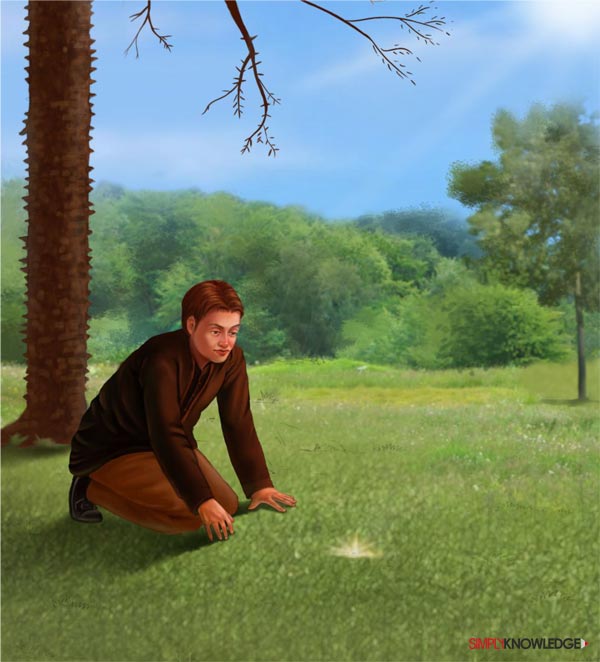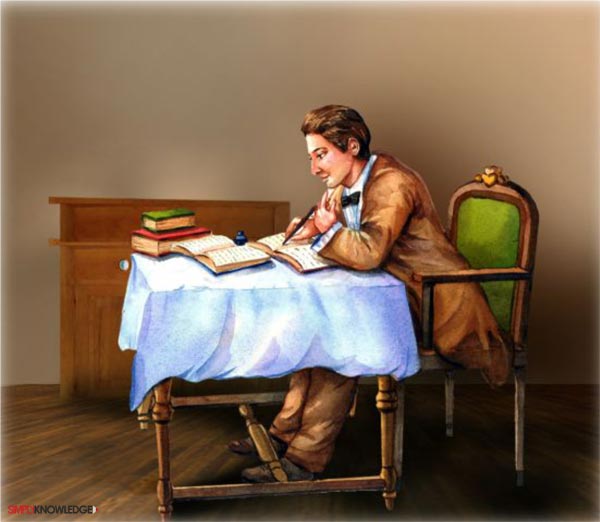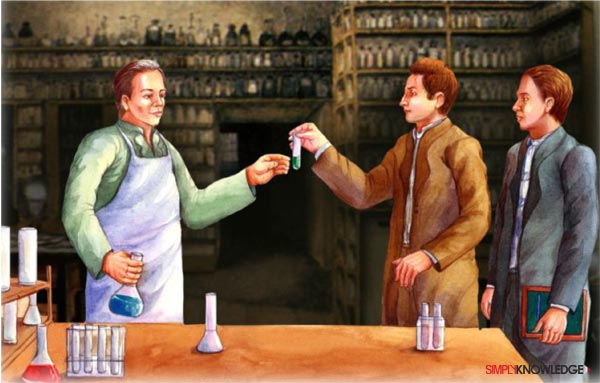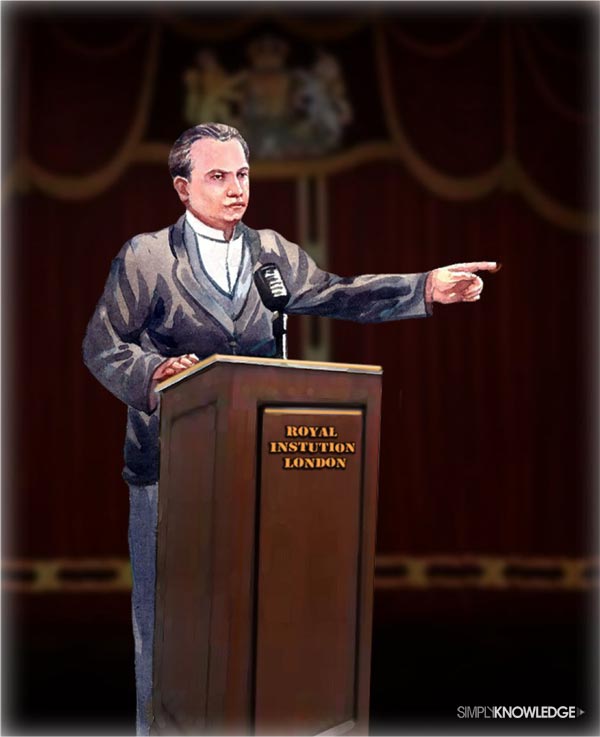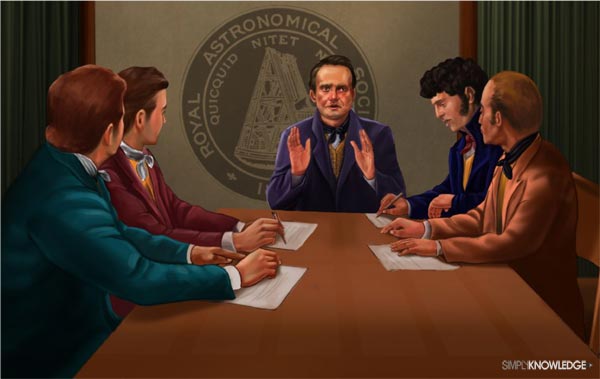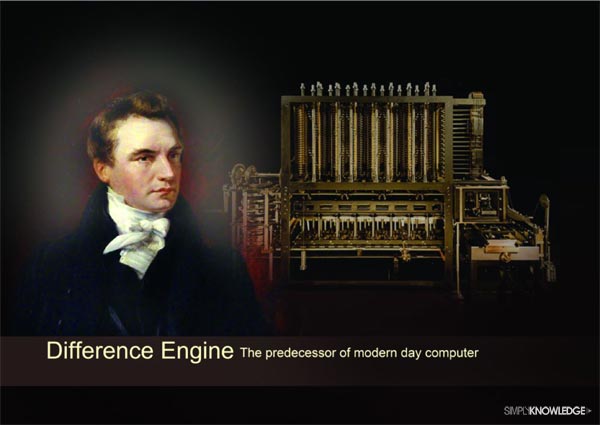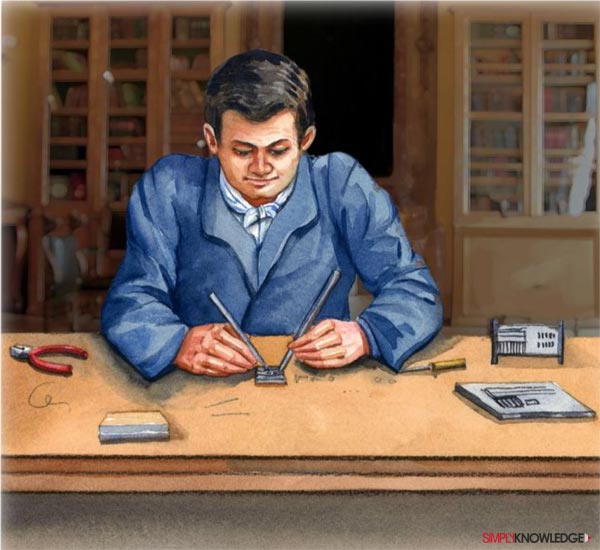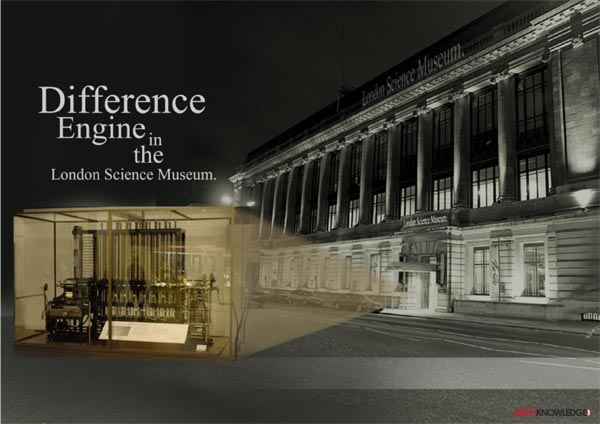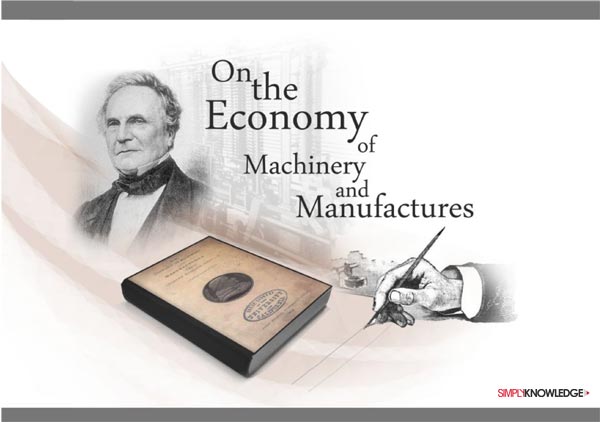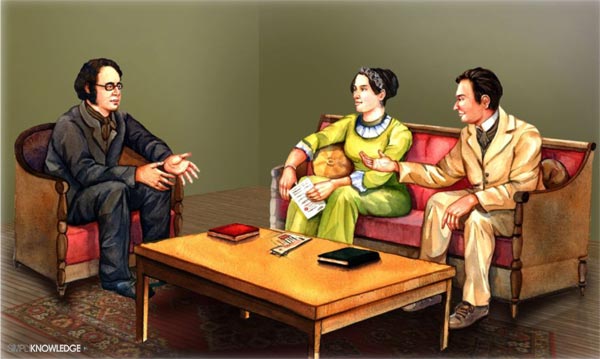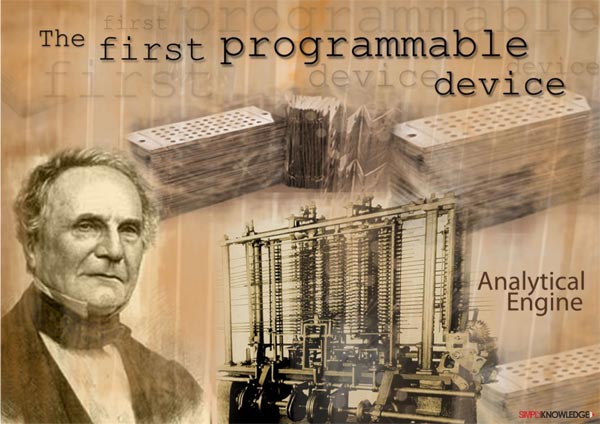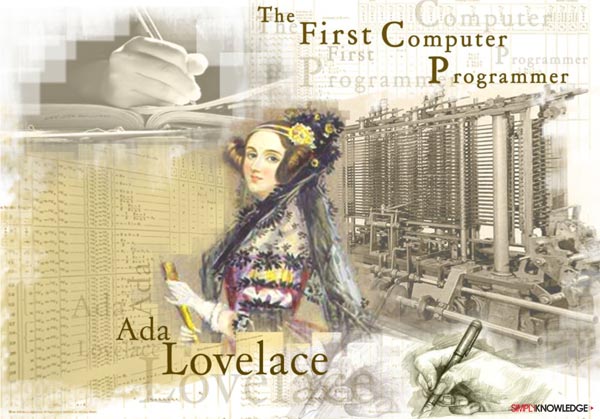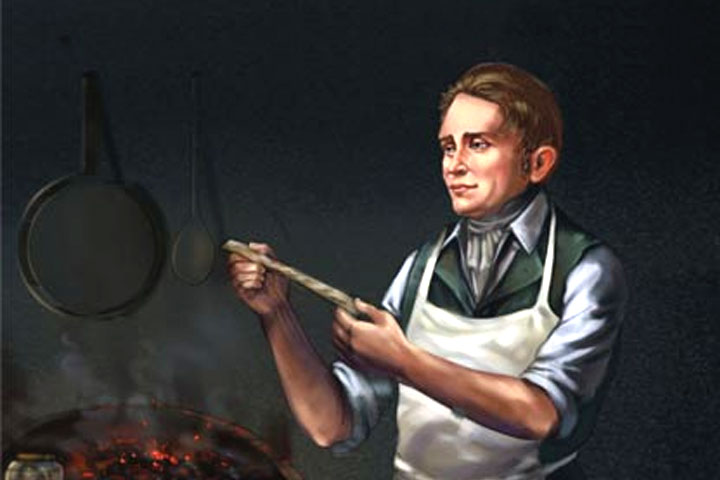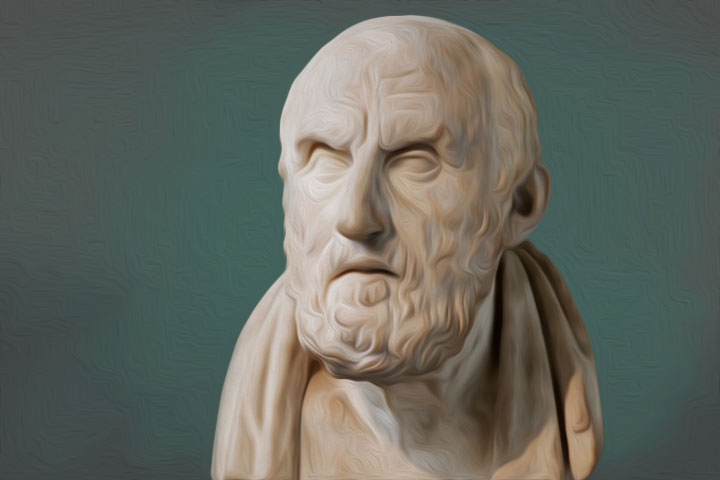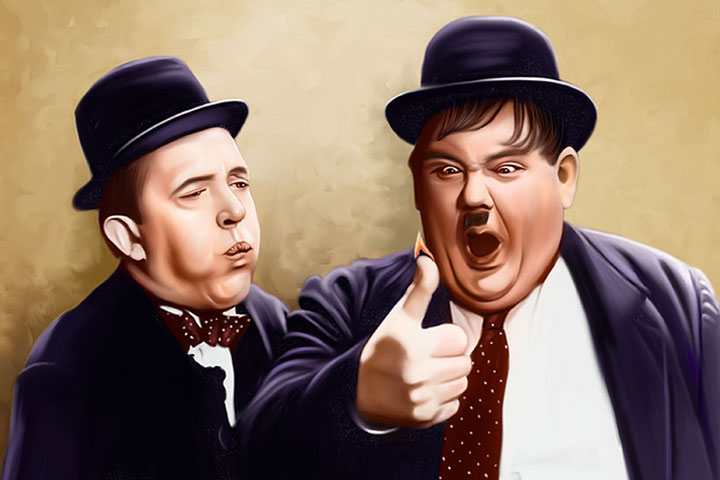
Introduction
“At each increase of knowledge, as well as on the contrivance of every new tool, human labour becomes abridged.”
This must have been the motto created by a man named Charles Babbage for himself that made him the man that he was; who is still honoured and remembered today and will be forever thereafter. It was this luminary who envisaged the various fundamentals of computing. He originated the concept of a programmable computer almost a century before its initiation. This is why he is considered the ‘Father of Computers’. Though his contributions and achievements are many, he is renowned for designing and inventing the vast mechanical calculating engines that were considered one of the amazing accomplishments of the 19th century. He dedicated most of his life, used up a major share of his wealth and a government subsidy to come up with a perfect mechanical calculating machine that gave way to more intricate modern day machines.
Being England’s one of the most famous scientists, mathematician and inventor, he was also a man of varied interests and pursuits. In spite of the agonizing childhood that he spent due to many illnesses, and the troubled personal life he went through on the loss of his family, he emerged unbeaten in his goals and passion in life.
This biography portrays the iron-willed man’s journey in life, his struggles and achievements, and most importantly how he pursued his dreams to mark his place in history.

A Mastermind Born Much Ahead His Time
Though there are extensive researches and information regarding Charles Babbage’s works and contributions, limited detail is known about his ancestral lineage. He was born on 26th December, 1791, in London, to Benjamin Babbage and Elizabeth (Betty) Plumleigh Teape. They had two more sons: Henry born in 1794 and another son named Henry too in 1796. However, both died in childhood. The couple later had a daughter in 1798 whom they named Mary Anne.
Both Benjamin and Elizabeth came from well-to-do respectable Devonshire families in the small town of Totnes. His paternal ancestors are said to be goldsmiths. Charles Babbage’s grandfather was a mayor in Totnes, and so were some of the ancestors from his maternal side.

The Genius’ Early Years
As a child, Charles Babbage was weak and fragile and got sick quite often. Despite this, he displayed immense inquisitiveness to any mechanical object. When his doubts about any object were not satisfactorily cleared, he would proceed to dismantle it to examine its working. Around the age of 10, Charles had a violent attack of fever that was almost fatal. His parents were advised by his doctor not to burden or worry him with studies. Charles’ parents were severely over-cautious about his condition as they had already lost two sons due to severe illness. They felt that London city’s air could further damage his health and therefore sent him to Dover countryside for some fresh air and to recuperate from his ill health. At Devonshire, he was placed under the care and guidance of a clergyman, who was instructed to attend to his health and not pressurise him with studies. The clergyman had a school at Alphington, near Exeter and this was where Charles Babbage pursued his primary education. Here he learnt English, Greek, and Latin languages. He was also taught accounting and navigation as these subjects were considered appropriate for sons from families that lived near the ports.
Apart from his interests in mechanical objects, Charles was also fascinated by the supernatural world. He believed in God, but was also curious about the occult practices. Common among young children to make up horror stories, Charles and his friends had their share of such eerie stories too. He had once scared an older boy who also fell sick with one such story. Charles had frightened him with a shadow cast by some mere object. But the realisation that someone else could also play the same trick on him, which could then make him consider the existence of spirits, spooked him. However, his curiosity overcame his fears and he decided to investigate the existence of ghosts himself. He chose a deserted garret for his experiment. He reached there around dusk one day, locked the door and cut his finger to draw blood. With his blood he drew a circle, stood inside it and recited the Lord’s Prayer backwards. He waited for a while for something unusual to appear but nothing happened. He then rushed back to his companions but did not mention a word about his experiment. However, the young boy’s mind was filled with guilt. He feared that his Almighty would be furious with him for having tried to find out the truth and falsehood of the religion he had been brought up with. He tried to console himself by concluding that God would not punish him for his childish curiosity.
In the meantime, his health restored slowly and steadily. This was a time when his young mind associated certain incidents as a solution to other smaller problems in life. It had further developed his thought process that helped him as a grown up too. One such learning incident was when he was at Alphington. He once skipped playing with his friends and retreated to a shrubbery where he rested himself on the lower branch of a thorn tree. Idle, listless and with nothing else to do, he imagined to have a headache. Suddenly he noticed a piece of metal shining below. Thinking it to be a valuable piece, he was thrilled to have found a treasure, and so rushed to his friends to show them his find. All their excitement came to an end when an adult on careful inspection declared that the square piece of brass metal was a half dram weight. It must have slipped out from the box of a pair of medical scales. The lesson that he learnt from this little incident played an important role in Charles’ adult life too. After this incident he realised that the discovery of a tiny piece of metal had completely diverted his mind of the headache he had felt then. He had understood the power of concentration.
A few years later Charles put this theory to practice. When he suffered from bouts of toothache, he often tried to divert his mind by reading the book Robinson Crusoe or a volume of Don Quixote. Though initially it was difficult to pay attention due to the pain, Charles felt that in a course of time the intense concentration in the novel made him forget his pains.
Charles exchanged his thoughts and beliefs with his best friend Dacres, son of Admiral Richard Dacres. This friend also shared similar ideas as of Charles. They had made an agreement with each other stating that whoever died first would appear before the other to clarify their doubts about the existence of life after death. A year or two later, Dacres joined the navy, but whenever he was ashore Charles would meet him frequently. Dacres worked in a ship under the command of Sir Thomas Duckworth. In due course he was sent home in charge of a ‘prize ship’ (An enemy ship captured as a prize of war). However, he faced severe hardships amid the long and turbulent voyage and later died of consumption around the age of 18. Charles had met him a few days before his death. Though they spoke of their childhood days, none of them mentioned a word about their agreement they had made long time back. The day his friend died, Charles, alone in his room, tried reading for a while but his intense curiosity took the better of him. He could not concentrate on what he read and so tried to sleep, which wasn’t possible either. He checked his room for any sign of the pact he had made with his friend. That is, he examined his room for any cat, bird or living animal.
These few instances throw light on some of Charles’ characteristic. Apart from his curiosity about the supernatural world, not only was he superstitious but also a lad with intense imagination. He may have never got answers to his doubts regarding the other world, but it must have been this quest for the unknown that led him to taking a scientific approach to things around him and make him the man that he was.

Life after Shifting to New School
Charles, now a young boy now, was much healthier. His interests had widened and not surprisingly, even at this young age, automation and machinery was one of them. During this period, his mother often took him to exhibitions of machinery. One such exhibition that fascinated him was at Hanover Square, by an exhibitor who called himself Merlin. He explained about certain objects on display to the public that they had access to. On noticing Charles’ interest and curiosity on the subject, Merlin suggested to his mother that he be taken to his workshop to have a glance at other mechanical collections too. Charles was more than happy to have received the offer, and accordingly went up the attic that occupied Merlin’s workshop.
With Charles’ health more stable now, Benjamin Babbage, Charles’ father, moved him to a new boarding school under Reverend Stephen Freeman. It was a 30-student academy located at Enfield, in the neighbourhood of London. Charles spent three years here but his experience in this new academy began on an unfortunate note. After the initial few weeks here, he had once gone to the playground at around dusk with one of his friends. Nearby was an orchard that belonged to their master, which had been robbed some time ago. On hearing people talking in the orchard and guessing them to be the robbers, Charles and his friend jumped up the boundary wall to catch hold of them. Unfortunately, the so imagined robbers were fellow students who had come to collect manure from a rotten mulberry tree for their flowers. On their return they were caught by their master and fined a shilling for wandering out of bounds. Charles never forgot that injustice as even after explaining and clarifying the situation, the master refused to believe them and made them pay a fine.
However, it was this school that built the right foundation for Charles’ formal education and career. The school housed an excellent library with about 300 well-selected volumes on various subjects. He made good use of the library and was of the opinion that every school should have one for the benefit of students. One of his favourite books in the library was a treatise on Algebra called ‘Ward's Young Mathematician's Guide’. It was here that he discovered and explored his love for Mathematics and fed this interest with as much knowledge as he could. It was probably Reverend Stephen Freeman, his master and also an amateur astronomer who developed his interest in this subject. Nevertheless, he was also notorious for his pranks at school like carving his name on the desks and violating curfew. Amidst all this, he still found time to wake up at three in the morning to study secretly with a friend.
Having heard of Charles’ stealthy study sessions, another boy, Frederick Marryat, requested him to also include him as part of the study group. Marryat who was taller and older to Charles told him that his sole object was to study and the practice session would be helpful in later years. But Charles refused this request and always tried to avoid Marryat join him as he felt that Marryat would only play and thus their focus on the subject would be affected. Marryat, who never left hope, always tried to come up with ways to persuade Charles. Finally, he had no choice but let the stubborn Marryat join him. However, his only condition was that no one else should be admitted to their group. All went on well for a while, but by and by some of Marryat’s friends too joined the group. And as Charles had anticipated, the maths sessions gave way for fun and mischief. Once their group lit fireworks in the playground and were eventually caught by the master. He later gave them a grave lecture on the impropriety of staying awake at night and the toll it would take on their health. Charles realised that the master had a clear picture of the actual purpose of the group and who had misled this purpose. From then on, Charles had a special liking for this master, and kept in touch with him for the rest of the master’s lifetime. Moreover, the master was a key figure who helped develop Charles’ interest in Mathematics.
In the meantime, Charles shifted his schooling from the Master’s (Reverend Stephen Freeman) academy. Being born to a rich father gave him the luxury to shift to several schools as per convenience and also avail private tuitions. After he left the Master’s Academy, he was entrusted under the guidance of two private tutors.
During the period that he stayed at his father’s place, Charles spent his time on one of his favourite pastimes – discovering new mechanical instruments. The grounds that surrounded the house extended to a beach and he made regular visits there. Even at this tender age, he was overwhelming with interests in coming up with mechanical inventions. When he was around 16, he tried to experiment with his father’s gun; he wanted to see if he could manage using it. After several charges of gunshot, he managed to hit a sea-bird called diver. Though the bird fell some distance away into the sea, he was adamant to get hold of his prey. He swam the distance in the chilling water and managed to catch the dead bird. The only impossible task was to eat it the next day after his cook roasted it for him. After this experience, he left the birds alone.
Shortly after this episode, another memorable mechanical trial that he came up with was his tryst to walk over water. He tried this experiment in a nearby river. He connected two boards to hinges and fixed it to the soles of his shoe. His scientific reasoning was that when he lifts up a leg (as done while walking), the boards would come close to each other; while on pushing his foot down, the water would rush between the boards and open up into a flat surface. This would offer greater resistance to sinking in the water. This technique worked for a while and he managed to keep his upper body above the water surface. Unfortunately, with the receding tide his apparatus got out of control and he almost drowned.

Admission in Cambridge
Charles now planned to join the Trinity College, Cambridge. And for the same, he was entrusted under the guidance of an Oxford tutor to be taught Classical Studies – an important criterion for a student to be accepted in Cambridge. Nonetheless, he kept his undying love for Mathematics. Apart from his coaching in the Classics, he also read mathematical books during this period.
In a short period of time he improved his knowledge on Classics and attained admission in October 1810 at Trinity College as desired. While with one of the Oxford tutor, he accidently heard of an idea of forming a universal language. Charles who was impressed with this idea soon began writing a special form of Grammar; assigning signs for words, and worked to come up with a dictionary for the same. However, he had to put an end to this attempt due to the impracticality of arranging signs in a successive order, as seen in normal dictionaries.
So thrilled was Charles about his entry into Trinity College that even before he could join there, he had formed plans to open a chess club with his future friends and another club to discuss topics related to mathematics. But he hardly knew what awaited him. In 1811, on his journey to Cambridge he purchased the great work of Sylvestre François Lacroix (a French mathematician), on ‘Differential and Integral Calculus’ from a French bookseller. He was misinformed earlier that the cost of the book was two guineas; but in spite of it being seven guineas, he purchased it because he had longed for the book for quite some time. On reaching Cambridge, he met his tutor, Hudson, then made arrangements for accommodation and spent most of that night reading his new book. A few days later, he met Hudson as he needed help with a mathematical problem. Sadly, Hudson just heard Charles’ question but didn’t bother to explain its solution, stating that it would not be asked in the examinations of the Senate House and that he should concentrate on more elementary topics instead. He met with the same fate when he approached another lecturer for a different mathematical problem. Then again the third time too, Charles was disappointed that a faculty was unable to address his doubt. Soon he formed a dislike for the education system there and engrossed himself in the papers of Euler and other mathematicians in the volumes of the academies of Petersburg, Berlin, and Paris, which were available in the library that he was using.

Formation of the Analytical Society
It was not just Charles who was disappointed with the mathematical guidance offered at Cambridge. With regards to Mathematics, England was far behind the rest of Europe due to the decision made by British Mathematicians. The purpose was to ignore the mathematical development in the continent in favour of British mathematicians. Therefore, a few undergraduates including Charles, John Herschel and George Peacock, founded the Analytical Society in 1812 to promote European mathematics as a more advanced subject than the mathematics of English physicist Isaac Newton, then taught at the university. Edward Bromhead (a friend of Charles’ friend) needs a special mention as it was he who initiated that such a society be formed. What brought the members of the society to each other was their common interest in the analytical approach to calculus and the disappointment on how the subject was taught in Cambridge.
The society favoured for an analytical approach in the differential and integral calculus and discouraged the use of geometrical demonstrations and the fluxional notation of Newton. The society’s goal was not to reform mathematical studies but to encourage analysis in Cambridge.
In 1813, Charles and John Herschel came up with the first publication of the Analytical Society – ‘Memoirs of the Analytical Society’. It was an in-depth piece of work considering that it was written by two undergraduates. The society administered two more publications with the combined efforts of Charles, John Herschel and George Peacock.

Man of Varied Interests
During his initial days at Cambridge, Charles held a keen interest in Chemistry too and had converted his spare room into a laboratory. He attended Chemistry lectures of Professor Smithson Tennant. Charles and John Herschel often assisted the professor in preparing his experiments. Though Charles’ interests strayed from his field, he utilised his knowledge on the subject in his future projects. Amidst the tryst with the Analytical Society, in 1812, Charles shifted from Trinity College and joined Peterhouse, Cambridge. It has been speculated that this shift was because he realised John Herschel and George Peacock to be better mathematicians than him and at Peterhouse, he was the best mathematician.
Charles’ rigorous research and study had once led him to the critical examination of logarithm tables that were used for accurate calculations. Considering the frequent errors that cropped up in the table, he decided to introduce manufacturing machines that calculated and printed without any human intervention, to eliminate errors in astronomical and mathematical tables.
Even after graduation, Charles was determined to produce his manufacturing machine. On returning home, he sketched a design of a machine that could compute all mathematical tables by a singular process. He was sure that it was technically possible for a machine to compute by successive differences and also print table when they were computed. While still working on this project, Charles went ahead with his plans of marriage, hence, could not follow up with this assignment at that time. He attained his bachelor degree in 1814, and ironically, the same year he lost his bachelorhood.

Marriage Sans his Father’s Approval
23 years old Charles married 22-year old Georgiana Whitmore, from a landowning Shropshire family, on 2nd July, 1814, at St. Michael's Church in Teignmouth, Devon. His father, Benjamin Babbage did not approve this marriage as he felt that Charles should have been financially well settled and earning steadily before committing to marriage. Benjamin Babbage had himself married only after he was well settled. In a letter dated 1st August, 1814, Charles wrote to his friend John Herschel, “I am married and have quarrelled with my father. He has no rational reason whatever; he has not one objection to my wife in any respect. But he hates the abstract idea of marriage and is uncommonly fond of money.” Nonetheless, in spite of this rift, his father continued to provide him the £300 annual allowance that he used to earlier. To this amount, Georgiana contributed her share of £150 pounds. With this total of £450, the family could afford a modest living though compromising on luxury.
Right after his wedding in 1814, Charles made up his mind to become an Anglican Minister and applied for several vacancies in the Church of England. However, his reputation as an unpatriotic liberal did not go well with the Church and hence his applications were rejected. After marriage the couple lived at Dudmaston Hall, Quatt, near Bridnorth, Shropshire owned by his father-in-law. The couple stayed there for significant periods and Charles even engineered the central heating system during his stay there. The very next year, on 6th August, 1815, their first child, Benjamin Herschel was born. Though the couple had eight children (seven sons and a daughter), only three of them survived to adulthood. Of all their children except Benjamin Herschel (1815-1878), the fifth son, Dugald Bromheald (1823-1901), and the sixth son Henry Prevost (1824-1918), the rest died young.
It was in the middle of September 1815 that Charles and his wife shifted to a small house at 5, Devonshire Street, Portland, and this became their family home. He then wasted no time in entering the scientific circles and was soon invited by the Royal Institution to give a series of lectures on Astronomy. It was Caroline, his friend John Herschel’s aunt who helped him attain the guidance of eminent astronomers of the period. Of the series of lectures Charles gave, drafts of nine remained. This work exhibited his astound knowledge on the topic and also formed a very interesting and renowned work on the history of Astronomy. Within a couple of years, Charles established himself strongly in the London scientific community.
John Herschel and his father sponsored Charles’ membership in the Royal Society of London. The Royal Society, founded in 1662, was England’s foremost scientific institution. It had Sir Isaac Newton as its president from 1702 to 1727. The Society published a monthly journal of scientific papers and also backed scientific expeditions abroad. Through Herschels’ influence, Charles got an opportunity to present a series of lectures at the Royal Society, which were well appreciated. Slowly he had placed himself in the limelight of London’s scientific society circles.

Career Fluctuations
During the year 1815, Charles’ scientific and inventive career had taken a small positive leap. His hard work proved fruitful, as on 14th March, 1816, a 24 year old Charles was elected a fellow of the Royal Society of London. Over the next few years, he wrote papers on varied mathematical topics, and the most recognized among them was the calculus of functions. In these works, he chose a branch of Mathematics hardly considered by his predecessors and transformed it into a systematic calculus. Over the next few years he penned down several more papers on mathematics. Though it was considered an honour to be a member of the Royal Society, Charles was not quite pleased there and was dissatisfied with the manner similar societies functioned. He once wrote his views on the Royal Society as, “The Council of the Royal Society is a collection of men who elect each other to office and then dine together at the expense of this society to praise each other over wine and give each other medals.”
Charles for a while had also considered paid employment just to prove to his father that he could earn his own livelihood. In 1816, he had applied for the post of math professor at East India College at Hartford but was not selected. In 1819, he applied again for a professorship, this time at Edinburgh. However, in spite of several recommendations from prominent French and English mathematicians, Charles failed to gain that position. During the same time, he also applied for a seat on the Board of Longitude (set up by the British government to encourage the submission of ideas, instruments and data that would help solve the navigational problem of finding longitude at sea) but that too was an unsuccessful attempt. In 1820, he made a new application but did not stand a chance. On the domestic side, his family life sailed smoothly without any financial problems.

Founding of the Astronomical Society
Amidst all these little failures, he attained his MA degree from Cambridge University in 1817. The year 1820 marked another important phase of his lifetime as he was elected member of the Royal Society of Edinburgh. In the same year he was a major influence in founding the Royal Astronomical Society with his Cambridge friends and few others, especially John Herschel and George Peacock. These young men realised that the Royal Society was not contributing much to Astronomy and was more of an elite social club as Charles had commented earlier. As a result, they decided to form a society of astronomers. On 12th January, 1820, 14 gentlemen, including John Herschel, Charles Babbage, Henry Colebrooke, Thomas Colby, Daniel Moore, Olinthus Gregory, William Pearson, and Francis Baily, dined at the Freemason’s Tavern in London to organise the Astronomical Society of London. The eight names mentioned above were the members unanimously selected to form a committee to set rules and regulations for the Society. At this first meeting Daniel Moore was elected to be Chairman, Francis Baily the Secretary, and John Herschel was asked to draw up an address which would explain the objectives of the new Society. Once into being, the Astronomical Society vehemently worked on the improvement of Astronomy in England. Its noteworthy contribution was its active work on enlarging and correcting the tables in the ‘Nautical Almanac’. A nautical almanac is a publication detailing the positions of a selection of celestial bodies for the purpose of enabling navigators to use celestial navigation to determine the position of their ship while at sea.
On 8th February, 1820, the Astronomical Society conducted its first general meeting in the Geological Society Rooms in Bedford Street, Covent Garden. By this date the new Society had 47 members, out of which 21 attended the meeting. It further increased to 83 members by the meeting on 2nd February, of which 28 members attended. Officers were elected at this meeting including the Duke of Somerset as President, Henry Colebrooke and William Herschel as Vice-Presidents, Pearson as Treasurer, Charles and Francis Baily as Secretaries, and John Herschel as Foreign Secretary. However, in a week’s time the President, the Duke of Somerset, wrote to the council his decision to the resign the Presidency. He clarified that the President of the Royal Society, Sir Joseph Banks, who was his close friend too, had persuaded him to not only resign his Presidency but also the membership, as he felt that the Astronomical Society would damage the Royal Society. William Herschel accepted the next Presidency, and on his death Henry Colbrook took over as the President. In February 1831, a decade after the founding of the Society, it sought a Charter. On 15th December, 1830, the King signed the book as Patron of the Society, and from that time on the Astronomical Society became the Royal Astronomical Society.

Reworking on his Dream Project
As a child, Charles Babbage was weak and fragile and got sick quite often. Despite this, he displayed immense inquisitiveness to any mechanical object. When his doubts about any object were not satisfactorily cleared, he would proceed to dismantle it to examine its working. Around the age of 10, Charles had a violent attack of fever that was almost fatal. His parents were advised by his doctor not to burden or worry him with studies. Charles’ parents were severely over-cautious about his condition as they had already lost two sons due to severe illness. They felt that London city’s air could further damage his health and therefore sent him to Dover countryside for some fresh air and to recuperate from his ill health. At Devonshire, he was placed under the care and guidance of a clergyman, who was instructed to attend to his health and not pressurise him with studies. The clergyman had a school at Alphington, near Exeter and this was where Charles Babbage pursued his primary education. Here he learnt English, Greek, and Latin languages. He was also taught accounting and navigation as these subjects were considered appropriate for sons from families that lived near the ports.
It was during the course of working on improving the tables of Nautical Almanac that Charles considered how such routine calculations could be worked out mechanically. This was a project that he had considered but left midway during his early years of college. During those days, numeric tables were calculated manually, which resulted in high error rate. He decided to build a machine that could calculate tables mechanically. A device to compute complex mathematical problems, calculate and correct errors in logarithm tables and astronomical charts. This machine, called the ‘Difference Engine’ created history for it is regarded the predecessor of modern day computer.
The purpose of the Difference Engine was to perform polynomial functions using very large sets of numbers that are entirely useful for both, logarithmic and trigonometric functions and calculations. Charles wanted the machine to calculate a sequence of values of a polynomial by the method of differences. The Difference Engine was designed to have the capability to print out also. This was a very noteworthy feature in terms of reducing the number of manual errors that took place during transfer of data. He was often disturbed by the errors that cropped up in astronomical and other calculations through the inaccuracies in the computation of tables. During that period such inaccuracies in navigational tables even caused shipwrecks. The field of Astronomy too required improved and accurate method of measuring and calculating to aid astronomical explorations. Charles began to build a small working prototype of the difference engine in 1819, and had it completed by 1822. The same year, on 3rd July, 1822, he wrote a letter to Sir Humphrey Davy, president of the Royal Society, about the possibility of introducing a machine for the calculation and printing of mathematical tables. On 18th June, 1822, he presented to the Astronomical Society a research paper on this machine, wherein he also announced about this invention. The research paper was titled ‘On the Theoretical Principles of the Machinery for Calculating Tables’; and the very next year, in 1823, he received the Royal Astronomical Society’s first Gold Medal.
Charles until then had self-funded his entire project. With the help of the Society he applied to the British Government for finance to make a larger machine – Difference Engine No. 1. This machine built to calculate a series of values automatically, used the method of finite differences by which it was possible to avoid the use of multiplication and division. In July 1823 Charles met with the Chancellor of the Exchequer, who granted funds and a go ahead to continue with this project. He was asked to come up with the real version of the Difference Engine, which he duly started in July 1823. It was designed to operate to the sixth order of difference, calculate numbers to the twentieth place, and print out 44 digits a minute. It needed hundreds of carefully machined components that worked in perfect coordination, as any slack in the gears might result in the engine going out of control. This was when he realised that the engine’s precise specifications could not be met without better machine tools. As a result he diverted his concentration into the design of new tools. It thus happened that, he would design a part or series of parts for the engine, and then design and build the tools to make them.
The British machine tool industry thus boomed to new heights, but, being the perfectionist that he was, Charles’ working pattern and constant efforts to improvise the design resulted in severe delay and high cost in the machine’s development. He repeatedly altered plans and made modifications all over the machine. A major share of his time and funds were utilised in reinventing and redesigning the parts that were already done. Even though he positively influenced the Government for more funding and several organisations including the Astronomical Society, backed this project development, Charles had to depend upon his personal financial resources due to cash flow problems. Such situation hampered his motivation and also caused delay in project completion. He often lost out on skilled labourers as they left citing that there was never continuous work. Though he received replacement labourers, a lot of time was wasted on training them all over again.
In the meantime, he stepped into other areas of interest too. In 1824, with his friend Francis Baily’s influence, Charles was invited by few investors to organise a life insurance company. The offer interested him and he took up the task to determine the suitable amount to be charged for life insurance policies. After gathering profuse information on the subject, he decided to make further use of it. In 1826, he published a book on the life insurance industry, ‘A Comparative View of the Various Institutions for the Assurance of Lives’. In less than 200 pages, this book offered a very handy consumer’s guide to the life insurance companies in England of that era.
Charles, along with William Herschel, conducted some experiments on magnetism in 1825 and published a paper on magnetization arising during rotation. In 1827, Charles accomplished another task as he published his Table of Logarithms of the Natural Numbers, from 1 to 108,000. His logarithms were by and large considered to be the most accurate of that period and were reprinted on many occasions, even into the 20th century. The year 1827 was also a devastating period with multiple tragedies in Charles’s life, which drained him emotionally. In February, he lost his father, Benjamin Babbage, in Devon. A well-planned man that he was, he left an ample amount that could take care of his wife Elizabeth (Betty) Plumleigh Teape. Betty then shifted to live with her son Charles and family. Charles inherited an estate worth £100,000 and also acquired a comfortable income for the rest of his life from the interest on investments and rent from properties. But the second blow hit him as he lost his 10-year old son, Charles Whitmore, to a childhood disease in July the same year. A month later, his young 35-year old wife Georgiana contracted a fatal disease and breathed her last on 1st September, along with her newborn son Alexander Forbes. The stress was so severe that he took to ill health and was on the verge of a breakdown. His medical advisers convinced him to travel abroad to recover, and so he left for Europe at the end of 1827. His children were entrusted under the care of his mother Betty.
Charles travelled through Netherlands, Belgium, Germany and Italy, visiting universities, manufacturing facilities and a lot of leading European scientists. This journey, apart from doing him good, also affected the construction of the Difference Engine. His absence did make a difference though he had left the required designs to enable the continuity of work and also co-ordinated with the mechanist regarding inquires related to the mechanism. While in Italy he learnt that he had been elected the Lucasian Professor of Mathematics at Cambridge University. Initially he had decided to turn down the position but changed his mind after his friends convinced him to accept the honour. He returned to England only at the end of 1828, and held the position for 12 years. However, in this long span of more than a decade, he never delivered a single lecture. The post was recognized as being one of the most prestigious academic posts in the world and a lot of responsibilities came along with it. Nonetheless, Charles considered that all these were not worth the distraction from the immense passion that he possessed on the development of mechanical computers.
The development of the Difference Engine was still progressing but several issues came in its path. However, John Herschel and the Royal Society publicly defended the Difference Engine. The government continued its support, advancing £1500 on 29th April, 1829, £3000 on 3rd December, and £3000 on 24th February, 1830. In 1832, there were enough parts to assemble a section of the engine. Consisting of six vertical axles and a few dozen gears, the section was around 24 inches high, 19 inches wide and 14 inches deep. It worked perfectly, solving equations to the second order of difference and yielding six-digit results. This amazing piece of machinery was one of the best and most sophisticated machines of its time. Though work continued, Charles still had continual difficulty with regards to cash flow from the British Government’s treasury. A factor that hampered the making of this machine was the issue he had with Joseph Clement. He was a highly skilled mechanic of the time and Charles depended on him for almost all practical work on the project. Their partnership worked fine until the time Charles wished to shift the location of the workshop. Charles had set up a two-storey, 50-feet long workshop behind his house, with a glass roof for lighting and a fireproof, dust-free room to place the machine. Clement refused to move his operations to the new workshop and demanded more pay for travelling across town to oversee construction. It often happened that Charles had to pay Clement out of his own pocket when the government lagged behind Clement's pay schedule. So, in response to Clement’s demands, Charles argued that he draw his pay directly from the treasury. Clement refused the proposal and stopped working. Unfortunately, as per the British Law of that era, the mechanic had the rights on all products that they worked on. Joseph Clement took this law to his advantage as he lawfully owned the plans of the Difference Engine. It is believed that he however did return the drawings to Charles. But the entire situation discouraged Charles to continue working on the project. However, after some time Clement finally handed over the goods. Charles wrote to the Treasury: “The drawings and parts of the Engine are at length in a place of safety – I am almost worn out with disgust and annoyance at the whole affair.”
What made matters worse was when Charles informed the government that he had conceived a much more powerful and versatile machine – an Analytical Engine – which rendered the Difference Engine obsolete. The Analytical Engine could do all that its predecessor could do, and a lot more too. Under the circumstances, he hinted that it might be a practical decision and aid cost cutting if the focus be shifted to the newer version rather than the Difference Engine. This was the last thing that the government needed to hear considering the amount it had invested on the project. The Difference Engine was thus never completed and by the time the project was fully terminated in 1842, the British Government had already invested £17,000, to which Charles had added an additional £20,000. A working model of the Difference Engine can be seen today in the London Science Museum. It was finally built in 1991 using technology of the era as a proof that his designs were genuine. As per his design, the Difference Engine was to be steam-powered and as huge as a locomotive.

More Publications and Inventions
In 1830, 38-year old Charles published ‘Reflections on the Decline of Science in England’. This was considered a controversial work as it was a fierce attack on the management of the Royal Society and other scientific men. He was impatient that the Royal Society was not coming up with significant reforms. The publication provided interesting insights on the state of scientific inquiry in England of that period. Nevertheless, he consulted friends across England and Scotland and together established the British Association for the Advancement of Science in 1831. Their model was the scientific congress of Germany and the prime objective was to hold yearly meetings of scientists at various centres throughout Britain. Charles became one of the three permanent trustees of the organisation. As the organisation flourished, its meetings were divided into categories devoted to a particular branch of science. At Cambridge in 1833, Charles set up a statistical section, of which he then became the chairman. A year later, in 1834, he established the Statistical Society of London, to encourage the gathering and analysis of information about the British economy’s progress.
In 1832, Charles published his most significant work, ‘On the Economy of Machinery and Manufactures’, in which he advocated an early form of what we call today ‘operational research’. It was a text mainly on Economics as applied to manufacturing, meant for a lay audience, particularly ambitious factory workers. The text surveyed manufacturing practices including printing and publishing, and examined the political, moral and economic factors affecting them. Most of the information cited in the book came from Charles’s direct observations of factories and workshops in Britain and on the continent. He absorbed the general principles from these places and compiled them into more than 30 chapters of this book. In a span of three years, there were four editions in England – One in America, and translations into German, French, Italian, Spanish, Swedish, and Russian.
In the meantime, his social life was also on an all time high. The most sought-after invitations in the London social circles of that period were the Saturday evening soirées hosted by Charles and his beloved daughter, Georgiana, at his house in Dorset Street. The initial motive behind such parties was to introduce his teenage children Herschel and Georgiana into the society. It was at one such party on 5th June, 1833, that Charles met young Augusta Ada Byron, the daughter of the famous poet Lord Byron. Her parents had separated a month after she was born in December 1815, hence she never knew her father. The young Ada was a mathematic prodigy and her mother Lady Byron, a trained mathematician also encouraged Ada in the subject. The common interest for the subject got Ada and Charles talking on various subjects related to Mathematics, logic and more. She was in awe with his calculating engine and it wasn’t before long that they became lifelong friends. She later married William King, Earl of Lovelace.
With passing time, the Babbage soirées became an important part of the London social scenario. But another emotional blow awaited Charles as his 17-year old daughter took ill severely due to scarlet fever, and left him forever in September 1834. Charles was devastated, and to deal with the grief he further engrossed himself into work and social parties. Most often the guests at his soirées came from all parts of the elite society and at times the number crossed even 200. The guest list consisted of scientists, literary eminences, doctors, surgeons, bishops, bankers, politicians, industrialists, lawyers, judges, actors, authors, artists, and civil dignitaries.
However, the social gatherings did not distract him from his career priorities. In 1837, he published his work ‘Ninth Bridgewater Treatise’. In this book he attempted to harmonise his scientific and religious beliefs. After the loss of his daughter Georgiana, Charles began to see a daughter figure in Ada Lovelace and she a father figure in him – to make up for a relationship that they both lacked. He also helped Ada pursue her mathematical studies with the great mathematician Augustus de Morgan in 1840 at the University of London.
Charles kept himself busy even when he was not involved completely with the calculating engines. All kinds of statistics interested him – from the heartbeat of a pig to the quantity of wood a man could saw in a specific amount of time. He was not bothered by the dangers involved lest he be able to learn something new from it. For example, he spent time in a large drying machine to test the human body's reaction to heat. In another instance, he spent five to six minutes inside a 129ºC (265ºF) oven, noting his pulse and the quantity of his perspiration. Yet another dangerous venture was his exploration of an active volcano. He descended into Italy's Mount Vesuvius to study the occurrence of mini eruptions. Having figured that the time between eruptions was about 10 minutes, he climbed down closer to the eruption site to have a look at liquid lava and note its movement. He remained there for six minutes allowing four minutes for his exit before the next eruption.
With regards to his inventions, he introduced cow-catcher (formally known as the pilot) in 1838, which is a metal frame attached in front of locomotives to clear obstructions off the tracks. With regards to railway inventions, in about the same year 1838, Charles came up with a Dynamometer car – a car used for measuring various aspects of locomotive performance. He set up a passenger carriage to be placed between an engine and train to record data on a roll of paper that moved continuously. It recorded data like the pulling force of the engine, a plot of the path of the carriage and the vertical shake of the carriage. Some other contributions included:
- ‘Standard Railroad Gauge’, to measure the width of railroads.
- ‘Occulting Lights Apparatus for Lighthouses’ (in about mid 1850), a system of occulting lights to distinguish lighthouses from one another by numbers.
- ‘Greenwich Time Signals’, a means of transmitting time telegraphically. Heliograph Ophthalmoscope, an instrument to examine the interior of the eye.
- Developed uniform postal rates and thereby established modern postal system in Britain.
- The first speedometer for railroads.
- Developed theories on mathematical code breaking.

The Analytical Engine
Charles had lost interest in the making of the Difference Engine long before its final wrap up in 1842. After splurging a fortune from the Government and his personal account on the construction of the new difference engine, he gave up in 1834. However, in the meantime, he had completed the initial drawings of the analytical engine – a different, more elegant and complex machine built from brass and iron, and powered by steam. This machine is considered the world’s first mechanical computer and included a processor, memory and a system to input information and output the results. Using punch cards, the Analytical Engine, could be programmed to calculate almost any function. Punch cards were paper cards containing several punch holes and an early method of data storage. The Analytical Engine could be controlled by a programme of commands that it would read from the punch cards. Any kind of mathematical formula could be punch on the punch cards and used as different functions of the machine. Hence, depending on the requirements of the required calculations, different types of cards could be temporarily inserted into the machine to operate the calculations of the Analytical Engine. This process of calculation also did away the need of a highly skilled operator, as no matter who operated the machine, there was a little possibility of making mistakes.
On the family front, Benjamin Herschel Babbage, the oldest son of Charles, along with his family and brother Dugald Bromheald Babbage, left for Italy in 1842 on a railway project. The two brothers went to Australia in 1851 to conduct a geological survey. Henry Prevost Babbage, another son of Charles, joined the Indian army in 1843. Betty, Charles’ mother, was left alone in the old house, where she died in 1844 in her mid-80s.
Charles on the other hand kept himself busy with his extreme passion of machine building. He made no written account of the Analytical Engine. It was in 1840, during a series of seminars on the Analytical Engine, that a young Italian engineer and Professor Federico Luigi Menabrea made notes of all his lectures. With these notes he prepared the paper titled ‘Notions sur la Machine Analytique de M. Charles’, which was published in French in Bibliothèque Universelle de Genève in October 1842. The paper described in detail the principal design and functions of the Analytical Engine and was the first extensive publication on computers and programming in the world. After publication of Menabrea’s paper, Charles was asked to write a paper for two British scientific journals (The Ladies Diary and Taylor's Scientific Memoirs). Accordingly, he requested Ada Lovelace to translate Menabrea's article into English. She spent nine months on the project and it was published in 1843 as ‘Taylor’s Scientific Memoirs’. Under Charles’ guidance, Ada gave additional explanations and more details of examples to show the power of the Analytical Engine. Her own views and ideas on the application and use of the Analytical Engine were presented in a series of notes that far exceeded the content of the original paper. In her final note ‘G’ (the notes were labelled alphabetically) she explained in detail an algorithm that would allow the device to compute Bernoulli numbers. It was due to this work that Ada Lovelace is regarded today as the first computer programmer in the world.
The making charges of the Analytical Engine was much beyond what Charles could afford and maybe technology of that period was not that advanced to have produced the engine. The government too was annoyed by not getting any final results in hand, and so had stopped funding his projects. The completed mill would have measured 15 feet in height, and 6 feet in diameter. The 100 digit store would stretch to 25 feet long. Charles built only small test parts for his new engine and a full engine was never completed. In 1842, following several failures to obtain finance from the First Lord of the Treasury, Charles approached Sir Robert Peel for funding. He too refused but offered Charles a knighthood instead. Charles refused the proposal and continued modifying and improving the design of the Analytical Engine at his own cost.
Between October 1846 and March 1849, Charles began working on the designs of Difference Engine No. 2, a streamlined version of no.1. It used only about 8000 parts, three times fewer than the first and was a marvel of mechanical engineering. Unlike the analytical engine that he continually tweaked and improvised, Charles did not try to modify the second difference engine after completing the initial design. However, as the government refused to fund the project he never constructed this design. Augusta Ada Lovelace, the first programmer and one of the few people who fully understood Charles' ideas, died of uterine cancer on 27th November, 1852, at the age of 36. She was buried, at her request, next to her father whom she never got to knew in her lifetime.
In 1854, Charles’ son, Henry Prevost who was now married and had a child, returned from India on a three-year furlough. The elated Charles welcomed his son and his wife warmly and also built a cosy nursery for their child in his home. He proved to be a more loving grandfather than he had been a father. In this duration he became close to his son and was more of a friend to him. Both of them attended parties together and travelled around England. Henry also engaged in mathematical studies to assist his father. His furlough concluded at the end of 1856, and Charles was left alone once again in the empty house as he bid his family farewell.

The Final Descending Years
Charles Babbage became a loner in his final years. He got used to a routine that lasted the most in his later life. He dedicated mornings and afternoons to writing or working on the Analytical Engine or Differential Engine. He then spent the evenings to dinner, followed by a party, play or the opera. In 1861, the 70-year old was becoming aware of his descending life, and so dedicated a portion of his time to write his life’s chronicle. His autobiography, ‘Passages from the Life of a Philosopher’, was published in 1864.
In spite of being a popular man in the London society circle, and the various achievements he had garnered in his lifetime, the failure to fully construct his calculating engines made him a sour man in his final years. Old age further made him ill-natured and unpopular. He had a dislike for commoners and the same could be noted in his writing ‘Observations of Street Nuisances’ in 1864, wherein he also tallied 165 nuisances over a period of 80 days. He despised street music too, and once wrote, “It is difficult to estimate the misery inflicted upon thousands of persons, and the absolute pecuniary penalty imposed upon multitudes of intellectual workers by the loss of their time, destroyed by organ-grinders and other similar nuisances.”
Charles Babbage on different occasions was offered both a Knighthood and Baronetcy. He declined both the honorary titles, insisting on a life peerage instead. That is, having all the privileges of a hereditary baron, including a seat in the House of Lords. Sadly for Charles Babbage, this appeal was never granted. On 18th October, 79-year old Charles Babbage breathed his last at his home on Dorset Street, London due to renal inadequacy, secondary to cystitis. At the end, he was supported by his son Henry Prevost, who was on a furlough again, and Edward Ryan, his brother-in-law and schoolmate. As family and a few friends walked his casket to the cemetery, they were escorted by just one carriage that belonged to the Duchess of Somerset. Charles Babbage was buried in London's Kensal Green Cemetery. It is said that post his death half of Charles Babbage's brain was preserved at the Hunterian Museum in the Royal College of Surgeons in London and the other half of the brain is on display in the Science Museum, London.

Commemorating the Virtuoso and his Inventions
After Charles Babbage’s death, the British Association for the Advancement of Science, in 1879, considered the chances of building an Analytical Engine from Charles Babbage’s plans. However, they concluded that such a huge project was beyond their ability and resources. After Charles Babbage’s death, his son Henry Prevost Babbage gained possession of his drawings and mechanisms. After retirement of services in India, Henry Babbage, in 1889, published the work ‘Babbage’s Calculating Engines’ – a collection of his father’s articles along with additions of his own. In an attempt to publicise his father’s calculating engines, Henry constructed six working demonstration models of the Difference Engine using the already fabricated parts made by his father. He distributed the models to universities in different countries; one of which was Harvard University.
In 1890, Herman Hollerith perceived the Analytical Engine and built his own machine based on Charles Babbage’s idea of using punch cards. Though Charles Babbage used punch cards for his analytical engine, it was never built, whereas Hollerith was successful in designing a machine that could accept input through punch cards. He was able to start his own business with this new machine –The Tabulation Machine Company. Later in 1924, this company was renamed as IBM (The International Business Machine Corporation).
In the 1920s, the Royal Nautical Almanac demonstrated a practical Difference Engine. Henry Babbage's Analytical Engine Mill is on display at the Science Museum in London. In 1991, the London Science Museum constructed a full and working model of Babbage's Difference Engine No. 2. It was a grand success that truly justified Charles Babbage's technical work. Nevertheless, the much more ambitious mission of building an Analytical Engine is underway. A UK-based campaign, Plan 28, has been launched to finally build this grand calculating Engine. The campaign is raising money to build the Analytical Engine using the same tools and processes that would have been used if Charles Babbage had to make it during his time.
Charles Babbage would have been the happiest man lest he lived up to see the efforts taken in the 21st century to complete his dream project. The world salutes the man who envisaged such a machine that was designed more than 100 years before computers were available.
“The whole of the developments and operations of analysis are now capable of being executed by machinery... As soon as an Analytical Engine exists, it will necessarily guide the future course of science.”
If only the British Government and the bureaucrats of Charles Babbage’s era had paid heed to this quote... If only his calculating machines were completed by him then... perhaps science and technology would have been more superior than what it is currently.
Next Biography





